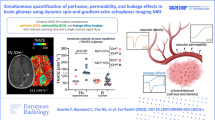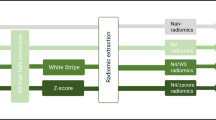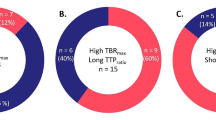Abstract
Purpose
An accurate assessment of the World Health Organization grade is vital for patients with pediatric gliomas to direct treatment planning. We aim to evaluate the diagnostic performance of whole-tumor histogram analysis of diffusion-weighted imaging (DWI) and dynamic susceptibility contrast-enhanced perfusion-weighted imaging (DSC-PWI) for differentiating pediatric high-grade gliomas from pediatric low-grade gliomas.
Methods
Sixty-eight pediatric patients (mean age, 10.47 ± 4.37 years; 42 boys) with histologically confirmed gliomas underwent preoperative MR examination. The conventional MRI features and whole-tumor histogram features extracted from apparent diffusion coefficient (ADC) and cerebral blood volume (CBV) maps were analyzed, respectively. Receiver operating characteristic curves and the binary logistic regression analysis were performed to determine the diagnostic performance of parameters.
Results
For conventional MRI features, location, hemorrhage and tumor margin showed significant difference between pediatric high- and low-grade gliomas (all, P < .05). For advanced MRI parameters, ten histogram features of ADC and CBV showed significant differences between pediatric high- and low-grade gliomas (all, P < .05). The diagnostic performance of the combination of DSC-PWI and DWI (AUC = 0.976, sensitivity = 100%, NPV = 100%) is superior to conventional MRI or DWI model, respectively (AUCcMRI = 0.700, AUCDWI = 0.830; both, P < .05).
Conclusion
The whole-tumor histogram analysis of DWI and DSC-PWI is a promising method for grading pediatric gliomas.




Similar content being viewed by others
Data availability
The datasets generated and/or analyzed during the current study are available from the corresponding author on reasonable request.
References
Jones DT, Mulholland SA, Pearson DM et al (2011) Adult grade II diffuse astrocytomas are genetically distinct from and more aggressive than their pediatric counterparts. Acta Neuropathol 121:753–761. https://doi.org/10.1007/s00401-011-0810-6
Paugh BS, Qu C, Jones C et al (2010) Integrated molecular genetic profiling of pediatric high-grade gliomas reveals key differences with the adult disease. J Clin Oncol 28:3061–3068. https://doi.org/10.1200/JCO.2009.26.7252
Louis DN, Perry A, Wesseling P et al (2021) The 2021 WHO Classification of Tumors of the Central Nervous System: a summary. Neuro Oncol 23:1231–1251. https://doi.org/10.1093/neuonc/noab106
Kline C, Felton E, Allen IE, Tahir P, Mueller S (2018) Survival outcomes in pediatric recurrent high-grade glioma: results of a 20-year systematic review and meta-analysis. J Neurooncol 137:103–110. https://doi.org/10.1007/s11060-017-2701-8
Zhang HW, Lyu GW, He WJ et al (2020) DSC and DCE Histogram Analyses of Glioma Biomarkers, Including IDH, MGMT, and TERT, on Differentiation and Survival. Acad Radiol 27:e263–e271. https://doi.org/10.1016/j.acra.2019.12.010
Xing Z, Yang X, She D, Lin Y, Zhang Y, Cao D (2017) IDH Noninvasive Assessment of Mutational Status in World Health Organization Grade II and III Astrocytomas Using DWI and DSC-PWI Combined with Conventional MR Imaging. AJNR Am J Neuroradiol 38:1138–1144. https://doi.org/10.3174/ajnr.A5171
Patel P, Baradaran H, Delgado D et al (2017) MR perfusion-weighted imaging in the evaluation of high-grade gliomas after treatment: a systematic review and meta-analysis. Neuro Oncol 19:118–127. https://doi.org/10.1093/neuonc/now148
Morana G, Tortora D, Staglianò S et al (2018) Pediatric astrocytic tumor grading: comparison between arterial spin labeling and dynamic susceptibility contrast MRI perfusion. Neuroradiology 60:437–446. https://doi.org/10.1007/s00234-018-1992-6
You SH, Choi SH, Kim TM et al (2018) Differentiation of High-Grade from Low-Grade Astrocytoma: Improvement in Diagnostic Accuracy and Reliability of Pharmacokinetic Parameters from DCE MR Imaging by Using Arterial Input Functions Obtained from DSC MR Imaging. Radiology 286:981–991. https://doi.org/10.1148/radiol.2017170764
Togao O, Hiwatashi A, Yamashita K et al (2016) Differentiation of high-grade and low-grade diffuse gliomas by intravoxel incoherent motion MR imaging. Neuro Oncol 18:132–141. https://doi.org/10.1093/neuonc/nov147
Server A, Kulle B, Gadmar ØB, Josefsen R, Kumar T, Nakstad PH (2011) Measurements of diagnostic examination performance using quantitative apparent diffusion coefficient and proton MR spectroscopic imaging in the preoperative evaluation of tumor grade in cerebral gliomas. Eur J Radiol 80:462–470. https://doi.org/10.1016/j.ejrad.2010.07.017
Zhu Q, Zou J, Ye J et al (2022) Comparative study of conventional ROI-based and volumetric histogram analysis derived from CT enhancement in differentiating malignant and benign renal tumors. Br J Radiol 95:20210801. https://doi.org/10.1259/bjr.20210801
Rezvani HR, Khoshpouri P, Ghadimi M et al (2020) Comparison between ROI-based and volumetric measurements in quantifying heterogeneity of liver stiffness using MR elastography. Eur Radiol 30:1609–1615. https://doi.org/10.1007/s00330-019-06478-0
Ahn SJ, Shin HJ, Chang JH, Lee SK (2014) Differentiation between primary cerebral lymphoma and glioblastoma using the apparent diffusion coefficient comparison of three different ROI methods. PLoS One 9:e112948. https://doi.org/10.1371/journal.pone.0112948
Gao A, Zhang H, Yan X et al (2022) Whole-Tumor Histogram Analysis of Multiple Diffusion Metrics for Glioma Genotyping. Radiology 302:652–661. https://doi.org/10.1148/radiol.210820
Vajapeyam S, Brown D, Ziaei A et al (2022) ADC Histogram Analysis of Pediatric Low-Grade Glioma Treated with Selumetinib: A Report from the Pediatric Brain Tumor Consortium. AJNR Am J Neuroradiol 43:455–461. https://doi.org/10.3174/ajnr.A7433
Xu Z, Yang L, Liu Q et al (2022) Machine Learning of Dose-Volume Histogram Parameters Predicting Overall Survival in Patients with Cervical Cancer Treated with Definitive Radiotherapy. J Oncol 2022:2643376. https://doi.org/10.1016/j.radonc.2020.11.030
De RR, Maris B, Cardobi N et al (2018) Can histogram analysis of MR images predict aggressiveness in pancreatic neuroendocrine tumors? Eur Radiol 28:2582–2591. https://doi.org/10.1007/s00330-017-5236-7
Sturm D, Pfister SM, Jones DTW (2017) Pediatric Gliomas: Current Concepts on Diagnosis, Biology, and Clinical Management. J Clin Oncol 35:2370–2377. https://doi.org/10.1200/JCO.2017.73.0242
Chiang JC, Ellison DW (2017) Molecular pathology of pediatric central nervous system tumours. J Pathol 241:159–172. https://doi.org/10.1002/path.4813
Cancer Imaging Archive website (2020) VASARI Research Project. https://www.wiki.cancerimagingarchive.net/display/Public/VASARI+Research+Project. Updated March 20, 2020. Accessed July 30, 2020.
Qi XX, Shi DF, Ren SX et al (2018) Histogram analysis of diffusion kurtosis imaging derived maps may distinguish between low and high grade gliomas before surgery. Eur Radiol 28:1748–1755. https://doi.org/10.1007/s00330-017-5108-1
Du N, Zhou X, Mao R et al (2022) Preoperative and Noninvasive Prediction of Gliomas Histopathological Grades and IDH Molecular Types Using Multiple MRI Characteristics. Front Oncol 12:873839. https://doi.org/10.3389/fonc.2022.873839
Yao R, Cheng A, Liu M, Zhang Z, Jin B, Yu H (2021) The Diagnostic Value of Apparent Diffusion Coefficient and Proton Magnetic Resonance Spectroscopy in the Grading of Pediatric Gliomas. J Comput Assist Tomogr 45:269–276. https://doi.org/10.1097/RCT.0000000000001130
Van SL, Kouwenberg V, Meijer F, Smits M, Henssen D (2022) A systematic review and meta-analysis on the differentiation of glioma grade and mutational status by use of perfusion-based magnetic resonance imaging. Insights Imaging 13:102. https://doi.org/10.1186/s13244-022-01230-7
Sudre CH, Panovska-Griffiths J, Sanverdi E et al (2020) Machine learning assisted DSC-MRI radiomics as a tool for glioma classification by grade and mutation status. BMC Med Inform Decis Mak 20:149. https://doi.org/10.1186/s12911-020-01163-5
Falk A, Fahlström M, Rostrup E et al (2014) Discrimination between glioma grades II and III in suspected low-grade gliomas using dynamic contrast-enhanced and dynamic susceptibility contrast perfusion MR imaging: a histogram analysis approach. Neuroradiology 56:1031–1038. https://doi.org/10.1007/s00234-014-1426-z
Zhang L, He L, Lugano R et al (2018) IDH mutation status is associated with distinct vascular gene expression signatures in lower-grade gliomas. Neuro Oncol 20:1505–1516. https://doi.org/10.1093/neuonc/noy088
Funding
This study was supported by the Leading Project of the Department of Science and Technology of Fujian Province (grant number 2020Y0025), the National Natural Science Foundation of China (grant number 82071869), and the Startup Fund for Scientific Research, Fujian Medical University (grant number 2018QH1048), the Young and Middle-aged Key Personnel Training Project of Fujian Provincial Health Commission (grant number 2021GGA025), and the Young and Middle-aged Key Personnel Training Project of Fujian Provincial Health Commission (grant number 2020GGA049s).
Author information
Authors and Affiliations
Corresponding author
Ethics declarations
Conflict of interest
The authors declare that they have no conflict of interest.
Ethical approval
All procedures performed in studies involving human participants were in accordance with the ethical standards of the institutional and/or national research committee and with the 1964 Helsinki declaration and its later amendments or comparable ethical standards.
For this type of study formal consent is not required.
Informed consent
The study was approved by our institutional review committee. Informed consent was waived off due to the retrospective nature of the study.
Additional information
Publisher's note
Springer Nature remains neutral with regard to jurisdictional claims in published maps and institutional affiliations.
Supplementary Information
Below is the link to the electronic supplementary material.
Rights and permissions
Springer Nature or its licensor (e.g. a society or other partner) holds exclusive rights to this article under a publishing agreement with the author(s) or other rightsholder(s); author self-archiving of the accepted manuscript version of this article is solely governed by the terms of such publishing agreement and applicable law.
About this article
Cite this article
Su, Y., Kang, J., Lin, X. et al. Whole-tumor histogram analysis of diffusion and perfusion metrics for noninvasive pediatric glioma grading. Neuroradiology 65, 1063–1071 (2023). https://doi.org/10.1007/s00234-023-03145-6
Received:
Accepted:
Published:
Issue Date:
DOI: https://doi.org/10.1007/s00234-023-03145-6




